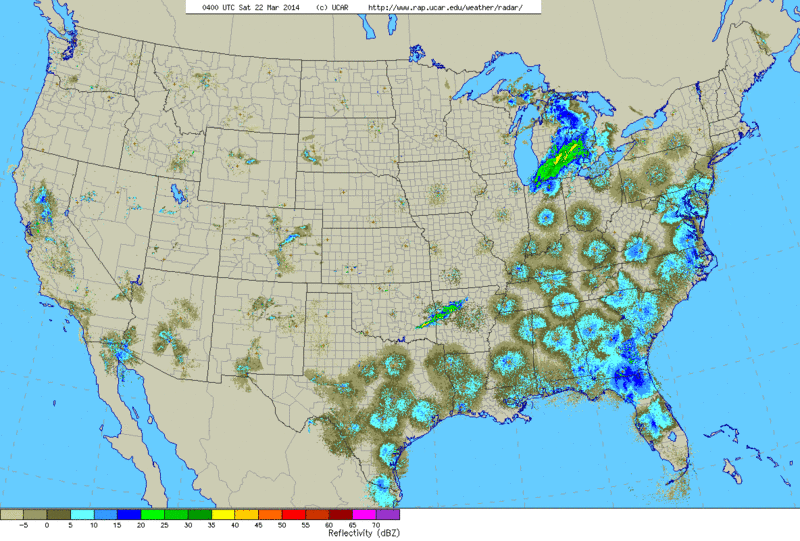Continental Summary
The West experienced scattered light to moderate movements as mostly unfavorable conditions for larger and more widespread flights did not materialize; the East saw pulses of light to moderate migration bracketing the forecast period. Species on the move this week included Blue-winged and Green-winged Teal, Greater Scaup, Hooded Merganser, Double-crested Cormorant, Great Blue Heron, Great Egret, Osprey, Sandhill Crane, Bonaparte’s Gull, Caspian Tern, Northern Flicker, Western Kingbird, Tree and Northern Rough-winged Swallows, Horned Lark, Hermit Thrush, Blue-gray Gnatcatcher, Louisiana Waterthrush, Worm-eating, Black-and-white, Prothonotary, Wilson’s and Lucy’s Warblers, Yellow-headed Blackbird, Scott’s, Hooded and Bullock’s Orioles, and Black-headed Grosbeak.
 West
West
Light to moderate movements occurred along the Pacific Coast and in the Desert Southwest to begin the weekend and early week, while widely scattered light movements occurred in across the remainder of the region. Most areas saw migration shut down by Tuesday as scattered precipitation arrived in some areas, with the exception of portions of southeastern California, Nevada, and Arizona. This pattern continued through the remainder of the week, as widely scattered precipitation across the region created unfavorable conditions for birds to move. Widely scattered light movements ended the forecast period. Species on the move this week included American Wigeon, Turkey Vulture, Osprey, Long-billed Curlew, Bonaparte’s Gull, Caspian Tern, Black-chinned and Rufous Hummingbirds, Northern Flicker, Western Kingbird, Cassin’s Vireo, Violet-green and Barn Swallows, Wilson’s and Lucy’s Warblers, Yellow-headed Blackbird, Scott’s, Hooded and Bullock’s Orioles, and Black-headed Grosbeak.
Great Plains
A quiet weekend across the Plains states did not awaken until Tuesday evening, when the central and southern portions of the region finally experienced scattered light to locally moderate movements. The pulse was short-lived, as unfavorable conditions returned the following day and persisted through the end of the period. Species on the move this week included Snow and Canada Geese, Green-winged and Blue-winged Teal, Gadwall, American White Pelican, Turkey Vulture, Northern Harrier, Red-tailed and Ferruginous Hawks, Greater Yellowlegs, Pectoral, Least and Baird’s Sandpipers, American Woodcock, Franklin’s Gull, Belted Kingfisher, Blue-gray Gnatcatcher, Western Meadowlark, and Chestnut-collared Longspur, and Savannah Sparrow.
Upper Midwest and Northeast
Light to moderate movements kicked off the weekend from the central Mississippi River valley north and east through the mid Atlantic states and northern Appalachians. However, a passing low pressure system shut down movements in its wake. Furthermore, the passage of this system heralded the arrival of unfavorable conditions across much of the region through the following week. Not until Thursday night did some favorable conditions creep back into the region, with scattered light movements in the Blue Ridge and DelMarVa areas. But precipitation and associated unfavorable conditions shut down migrants elsewhere across the region. Species on the move this week included Blue-winged and Green-winged Teal, Wood Duck, Greater Scaup, Hooded Merganser, Red-necked Grebe, Double-crested Cormorant, Great Blue Heron, Great Egret, Osprey, Sandhill Crane, Wilson’s Snipe, American Woodcock, Snowy Owl, Eastern Phoebe, Tree and Northern Rough-winged Swallows, Horned Lark, and Hermit Thrush.
Gulf Coast and Southeast
Light to moderate movements were widespread across the region on Friday night, particularly from northern Florida north into the southeastern Coastal Plain. As unfavorable conditions associated with arriving low pressure and precipitation pressed into the region, these movements became increasingly restricted to coastal areas as the weekend progressed. Eventually, unfavorable conditions shut down movements across most of the region by Sunday night. As this system passed, changeable conditions overspread much of the region, with light to moderate movements scattered widely where locally marginal or favorable conditions occurred. More widespread movements did not return to the region until Thursday night and Friday, when moderate movements occurred in Texas and Florida, and locally north along the Atlantic coast east of the Appalachians. Species on the move this week included Broad-winged Hawk, Solitary Sandpiper, Ruby-throated Hummingbird, Chimney Swift, Eastern Kingbird, Northern Rough-winged and Barn Swallows, Purple Martin, White-eyed and Yellow-throated Vireos, Blue-gray Gnatcatcher, Louisiana Waterthrush, Worm-eating, Black-and-white, Prothonotary and Hooded Warblers.




